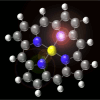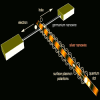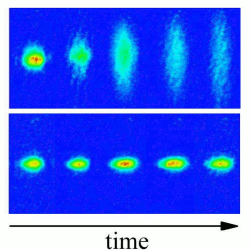-
Viewpoint on 'IONS'
Viewpoint on 'Scientific Literacy'
- Proudly sponsored by
-


-
The Ultimate Resolution

Even the best microscopes in the world cannot see the details of single molecules. Now, researchers have found a way to image these details, taking another step towards a better understanding of molecular physics and designer molecules.
-
Plasmon Harvesting: A Route to Plasmonic Circuitry

What cannot be seen can often be felt, even in the case of physics. Invisible surface plasmons trapped inside a nanowire can now be detected by converting them into an electrical current.
-
Forging Quantum Teams

A rowing team consists of a given number of athletes; adding or subtracting one would make it impossible for the team to compete. Recent experiments have shown that conditions exist under which quantum particles can also team up in a controlled number.
Volume 1 Story 1 - 12/6/2008

In a prison, thick walls keep culprits in place.
This is also the way particles are usually forced to stay in place.
Now atoms have been localized without walls, just by using disorder, in experiments with matter waves.
In some sense, this corresponds to putting prisoners in a roughly ploughed field. In a quantum world, instead of running away, they would all go to a definite point and stay there. They would be localized without walls. This phenomenon, first predicted fifty years ago, is called Anderson Localization. Now, it has finally been observed experimentally in matter waves by two groups: at the Laboratoire Charles Fabry of the French Institut d'Optique (LCFIO) near Paris and at the Italian based European Laboratory for Non-Linear Spectroscopy (LENS) in Florence.
Around the middle of the twentieth century, Philip W. Anderson studied why certain materials are insulators even though, according to conventional understanding, they should conduct electricity [1]. He showed that when dealing with waves, disorder inside a material can lead to an interesting effect: the wave concentrates at one spot and decreases very rapidly as you move away. When dealing with the quantum description of particles, the intensity of the wave indicates the likelihood of finding a particle in a certain place: the higher the intensity, the higher the probability. The fact that disorder can localize waves in this way is called Anderson Localization [2,3].
Researchers at LCFIO cooled a gas of Rubidium atoms down to almost absolute zero temperature, where the atoms collectively start to show pure quantum behaviour. "To use an analogy," says Laurent Sanchez-Palencia, "it is like when water turns into ice, its properties change and you begin to see new aspects of these molecules. However, when going to extremely low temperatures, the change in behaviour is a lot more dramatic. The gas particles stop moving around like billiard balls. Instead, they all start behaving identically, like photons in a laser. They undergo a phase transition to form a Bose-Einstein Condensate (BEC). In a laser, all the photons are identical and a high intensity of the light wave means that there are many photons. In a BEC, all the atoms are indistinguishable and a high intensity of the probability wave means that there are many particles. In fact, we can even observe interference effects which are typical wave phenomena in a BEC. Therefore, we can resort to the intuitive idea of a matter wave and use the strong intuitive analogy between atoms in a BEC and photons." In their experiment, disorder was produced by shining a laser on a diffuse plate, called speckle. The scattered light had a very irregular, yet well controlled, intensity distribution and was used to generate the disorder.
The result of the experiment was that most particles concentrated at one point in the disordered region. Moreover, as the intensity of the disorder was increased, they become more and more concentrated. On top of this, they localize exponentially, as expected for Anderson Localization in this system. "In recent years, there has been a real quest for Anderson Localization, and" Sanchez-Palencia points out "in Florence, they have done a related experiment almost at the same time using a different method for generating the disordered field and observing different quantities. And they also find clear evidence of Anderson Localization."
The Florence experiment is rather different with respect to the techniques. "We used Potassium atoms to make our BEC and used pseudo-random potentials instead of speckles," says Michele Modugno from the Florence group. "Anderson Localization was originally proposed for non-interacting systems. What our experiment adds is the possibility to control interactions between the atoms in the BEC and to study their role. Hereby we add even another control parameter to our experiments, which allows for very elaborate studies of these problems."
The reason for this tremendous effort, both scientists agree, is that controlling matter waves to such extent allows for very general experiments on disordered systems. "When dealing with a disordered system, analytical calculation and computer simulation are often extremely cumbersome," Sanchez-Palencia explains. "If we control the experiment to that extent, we can start investigating more disorder effects in quantum systems or even in nanotechnology that is going towards the quantum limit. Simply put, such quantum simulators can help shed light onto many open questions of the physics of disordered systems or even upcoming high-tech applications."
"Another nice aspect of these experiments," adds Jan Wehr from Arizona University, "is that they show how disorder is not always a nuisance. Without disorder, the atoms would not localize in these experiments; so disorder, in this context, is not detrimental. On the contrary, it is very constructive if you want to keep the particles in place. Disordered systems are extremely challenging for us. Therefore," he concludes, "we can expect a lot of input for mathematicians, physicists and maybe even engineers from this kind of experiment to foster a variety of interesting new research."
[1] P. W. Anderson, Absence of diffusion in certain rantom lattices, Phys Rev 109, 1492-1505 (1958).
[2] L. Sanchez-Palencia et al., Disorder-Induced trapping versus Anderson localization in Bose-Einstein condensates expanding in disordered potentials, New J Phys 10, 045019 (2008).
[3] L. Fallani et al., Bose-Einstein condensates in disordered potentials, Adv Atom Mol Opt Phys 56, to be published (2008).

 The animation shows a BEC expanding for different levels of disorder Delta/J.
The crossover between ballistic expansion (left) and localization (right) is clearly shown.
The animation shows a BEC expanding for different levels of disorder Delta/J.
The crossover between ballistic expansion (left) and localization (right) is clearly shown.
The Disordered Quantum Prison
Imagine a prison without walls, an open field where prisoners cannot leave simply because the field is not smooth. This is the idea behind Anderson Localization and has recently been observed in ultracold atomic gases.
Localized by disorder. Images of temporal evolution of the Bose-Einstein Condensate (BEC). Without disorder (top) the BEC expands freely in the non-confined direction, shown as vertical. With disorder (bottom) the BEC stays localized. Image courtesy of LENS.
Around the middle of the twentieth century, Philip W. Anderson studied why certain materials are insulators even though, according to conventional understanding, they should conduct electricity [1]. He showed that when dealing with waves, disorder inside a material can lead to an interesting effect: the wave concentrates at one spot and decreases very rapidly as you move away. When dealing with the quantum description of particles, the intensity of the wave indicates the likelihood of finding a particle in a certain place: the higher the intensity, the higher the probability. The fact that disorder can localize waves in this way is called Anderson Localization [2,3].
Researchers at LCFIO cooled a gas of Rubidium atoms down to almost absolute zero temperature, where the atoms collectively start to show pure quantum behaviour. "To use an analogy," says Laurent Sanchez-Palencia, "it is like when water turns into ice, its properties change and you begin to see new aspects of these molecules. However, when going to extremely low temperatures, the change in behaviour is a lot more dramatic. The gas particles stop moving around like billiard balls. Instead, they all start behaving identically, like photons in a laser. They undergo a phase transition to form a Bose-Einstein Condensate (BEC). In a laser, all the photons are identical and a high intensity of the light wave means that there are many photons. In a BEC, all the atoms are indistinguishable and a high intensity of the probability wave means that there are many particles. In fact, we can even observe interference effects which are typical wave phenomena in a BEC. Therefore, we can resort to the intuitive idea of a matter wave and use the strong intuitive analogy between atoms in a BEC and photons." In their experiment, disorder was produced by shining a laser on a diffuse plate, called speckle. The scattered light had a very irregular, yet well controlled, intensity distribution and was used to generate the disorder.
The result of the experiment was that most particles concentrated at one point in the disordered region. Moreover, as the intensity of the disorder was increased, they become more and more concentrated. On top of this, they localize exponentially, as expected for Anderson Localization in this system. "In recent years, there has been a real quest for Anderson Localization, and" Sanchez-Palencia points out "in Florence, they have done a related experiment almost at the same time using a different method for generating the disordered field and observing different quantities. And they also find clear evidence of Anderson Localization."
The Florence experiment is rather different with respect to the techniques. "We used Potassium atoms to make our BEC and used pseudo-random potentials instead of speckles," says Michele Modugno from the Florence group. "Anderson Localization was originally proposed for non-interacting systems. What our experiment adds is the possibility to control interactions between the atoms in the BEC and to study their role. Hereby we add even another control parameter to our experiments, which allows for very elaborate studies of these problems."
The reason for this tremendous effort, both scientists agree, is that controlling matter waves to such extent allows for very general experiments on disordered systems. "When dealing with a disordered system, analytical calculation and computer simulation are often extremely cumbersome," Sanchez-Palencia explains. "If we control the experiment to that extent, we can start investigating more disorder effects in quantum systems or even in nanotechnology that is going towards the quantum limit. Simply put, such quantum simulators can help shed light onto many open questions of the physics of disordered systems or even upcoming high-tech applications."
"Another nice aspect of these experiments," adds Jan Wehr from Arizona University, "is that they show how disorder is not always a nuisance. Without disorder, the atoms would not localize in these experiments; so disorder, in this context, is not detrimental. On the contrary, it is very constructive if you want to keep the particles in place. Disordered systems are extremely challenging for us. Therefore," he concludes, "we can expect a lot of input for mathematicians, physicists and maybe even engineers from this kind of experiment to foster a variety of interesting new research."
[1] P. W. Anderson, Absence of diffusion in certain rantom lattices, Phys Rev 109, 1492-1505 (1958).
[2] L. Sanchez-Palencia et al., Disorder-Induced trapping versus Anderson localization in Bose-Einstein condensates expanding in disordered potentials, New J Phys 10, 045019 (2008).
[3] L. Fallani et al., Bose-Einstein condensates in disordered potentials, Adv Atom Mol Opt Phys 56, to be published (2008).
Armand Niederberger
2008 © Optics & Photonics Focus
AN is currently working on his PhD on disordered ultracold quantum systems at The Institute of Photonic Sciences (ICFO) in Barcelona (Spain).

J. Billy et al., Direct observation of Anderson localization of matter waves in a controlled disorder, Nature (2008) 453, 891-894 (link).
G. Roati et al., Anderson localization of a non-interacting Bose-Einstein condensate, Nature (2008) 453, 895-898 (link).
 The animation shows a BEC expanding for different levels of disorder Delta/J.
The crossover between ballistic expansion (left) and localization (right) is clearly shown.
The animation shows a BEC expanding for different levels of disorder Delta/J.
The crossover between ballistic expansion (left) and localization (right) is clearly shown.